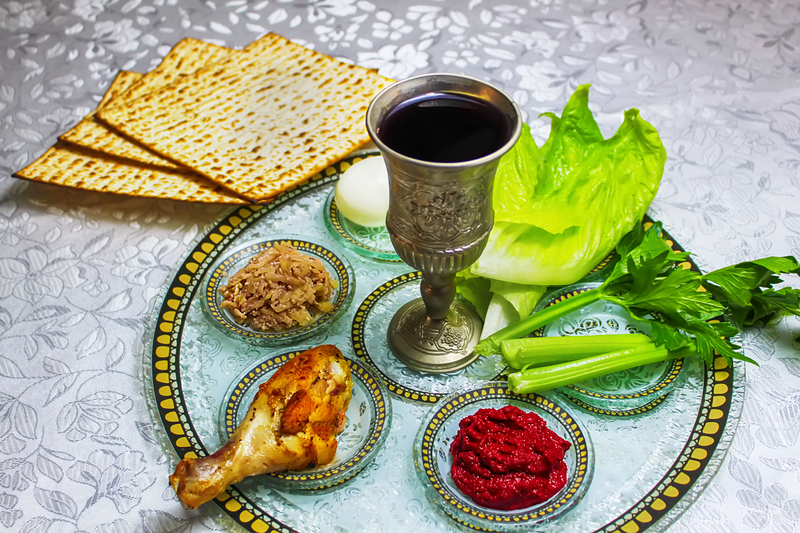
A MetaSpiritual Interpretation of the Seder
The Seder is a ritual feast that marks the beginning of Passover in Jewish tradition. It involves a series of rituals, songs, liturgy, and symbolic foods that commemorate the Israelites' Exodus from Egypt to claim their freedom. As we are preparing to attend our first Seder meal, we have been doing some research -- so we can participate fully in the experience. As we read more about this tradition, we realized that the powerful ritual contains deep MetaSpiritual meaning for us.
With absolute respect and appreciation of the Seder and all it represents, we invite you to join us in our exploration of a MetaSpiritual (metaphysical) interpretation of the Seder, where each element represents some aspect of our inner spiritual journey.
The Seder Plate
This central element of the Seder table is the Seder Plate, which holds six different symbolic foods.
- Beitzah - roasted egg;
- Zeroa - a lamb shank bone;
- Charoset (a mixture of apples, nuts, and cinnamon)
- Karpas - parsley dipped in salt water;
- Maror - bitter herbs (usually horseradish) - often dipped in the Charoset to reduce its sharpness;
- Chazeret - lettuce, an additional bitter herb; and
Additionally, there is wine and matzah bread included in the symbolic meal that correlates with the Exodus story.
MetaSpiritually, a plate represents unity or wholeness. The Seder Plate can be seen as a representation of the different aspects of our Beingness we need to enrich so we are able to align with our Higher Nature on our journey to Spiritual Enlightenment. Let's explore this more deeply.
Matzah - Unleavened Bread
Matzah bread represents the rushed departure from Egypt where there was no time for dough to rise, and it serves as a reminder of the past and a call to action for freedom in the present.
In our spiritual journey, it represents embracing our spiritual freedom as we release what no longer serves us, including old dogma and beliefs.
Beltzah - Roasted Egg
The roasted egg is symbolic of the festival sacrifice made in biblical times. It is also a symbol of spring - the season in which Passover is always celebrated.
MetaSpiritually, it represents the potential for new life and the continuous cycle of growth and renewal within us.
Zeroa - Lamb Shank Bone
The shank bone is symbolic of the sacrifice of the lamb, using its blood as a signal for the Angel of Death to "pass over" each Jewish home.
MetaSpiritually, it symbolizes the strength and courage needed to overcome our inner obstacles and achieve liberation.
Charoset - Sweet Mixture
This sweet paste, made of apples, nuts, and cinnamon, symbolizes the mortar used by the Israelites in their forced labor.
MetaSpiritually, it represents the sweetness that can be found even in difficult times, reminding us to find joy and gratitude amidst challenges.
Karpas - Parsley Dipped in Salt Water
Typically a green vegetable, karpas is dipped in saltwater during the Seder. It symbolizes both the tears of the Israelites during their slavery in Egypt and their hope for a better future.
MetaSpiritually, it represents our release of the past, letting go of grudges, regrets, and self-condemnation, and anticipation of our potential for new beginnings.
Maror - Bitter Herbs
These herbs remind us of the bitterness of slavery.
MetaSpiritually, they represent the painful experiences and challenges in our lives that, although difficult, contribute to our growth and transformation, when we choose to use every situation and what we have learned from it for good.
Chazeret - Lettuce
Lettuce is often used in addition to the maror as a bitter herb. The authorities are divided on the requirement of chazeret, so not all communities use it. Since the commandment (in Numbers 9:11) to eat the paschal lamb "with unleavened bread and bitter herbs" uses the plural ("bitter herbs"), most seder plates have a place for chazeret. It symbolizes the bitterness and harshness of the slavery experience.
MetaSpiritually, it serves as a reminder of the pain and bitterness we experience when we enslave ourselves by choosing material over spiritual values and practices.
Four Cups of Wine
These cups represent the four expressions of deliverance promised to the Israelites by God: I will bring you out; I will deliver you; I will redeem you; and I will take you to Me for a people.
MetaSpiritually, they can symbolize the stages of our spiritual liberation as we align with our Divine Nature: awareness, acceptance, transformation, and enlightenment.
The Haggadah
This is the text recited during the Seder, ritualistically and symbolically retelling the story of the Exodus. Beyond the historical retelling of the story, the Seder is an opportunity for connection, community, and personal discovery and understanding.
MetaSpiritually, it represents the narrative of our own lives, encouraging us to reflect on our personal stories and the lessons they hold for our spiritual development, recognizing the value of community and spiritual connections.
In this MetaSpiritual interpretation, the Seder becomes a journey of self-discovery and spiritual awakening, where each element invites us to reflect on our inner lives and the path to personal and spiritual freedom. We live in this incredible Field of Infinite Potential -- let's free ourselves from the bondage of our past choices, our regrets, our old beliefs, our grudges ... everything that is holding us captive ... and walk into the Infinite with Joy, Inner Peace, Love, and Expectation!
To all our Jewish friends (and those we've not yet met), Chag Pesach Sameach!

